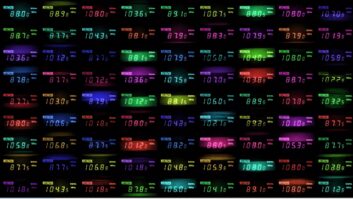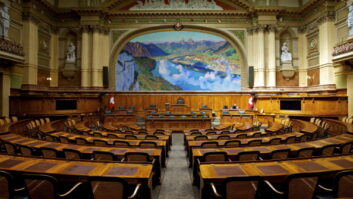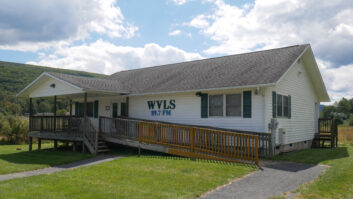WASHINGTON Will numerous radio stations apply to the FCC for permission to transmit in-band, on-channel signals, now that the commission has issued an initial endorsement of the service?
WOR Goes ‘HD’NEW YORK WOR(AM) began transmitting a digital signal in addition to its analog on Oct. 11, the day after the FCC gave its initial endorsement to IBOC. The station had received experimental authority to go digital before the commission formally acted on Oct. 10.
WOR claims to be the first 50 kW AM in that state to go digital and has changed its slogan to “710 WOR-HD.” The station’s experience is being watched closely because of its size, because it is in New York and because it is on AM.
Engineers for the Buckley Broadcasting station expressed pleasure with both the analog and digital signals they were hearing.
“It sounds like FM,” said Chief Engineer Kerry Richards. WOR personnel could hear the digital signal on HD Radios as they rode around the area in Ibiquity’s test van. Ibiquity provided another digital radio for the transmitter site.
What does he think of HD Radio? “Give me radios. We need them now. For AM broadcasters, this is a Godsend,” said Richards.
As AM IBOC is authorized only for daytime use at this time, WOR is transmitting the hybrid signals during the day, and operating analog-only at night.
The analog signal is being transmitted at full power; the aggregate power level of the digital signal is 6 dB lower than recommended, at 22 dB below the main carrier. Buckley Director of Engineering Tom Ray said Ibiquity requested that the station use the lower level, so its engineers could study the effects on WOR’s analog signal and that of its neighbor stations.
WOR is using a four-year-old Harris DX 50 transmitter with two CAT-5 cables running from the Ibiquity exciter into a three-tower directional array with no pattern change to the antenna. The conversion took approximately three hours with one modification to the transmitter, fixing a relay in the oscillator circuit.
Ray and Richards disputed published reports in some trade press which surmised that the first digital exciter Ibiquity provided to WOR had “overheated.” The unit failed on Oct. 14; WOR turned off the digital signal before noon and switched to the auxiliary transmitter. The station was back on the air with just its analog signal. The reason for the failure was undetermined at press time.
The next day, Ibiquity supplied another exciter, and the station returned to IBOC transmission by day.
The WOR engineers said they received only one complaint in the first few days about increased noise on the analog signal, from someone listening on a wide-band radio. It received no immediate complaints about interference from other stations in the area. Both Richards and Ray said several engineers from surrounding stations had asked them about the conversion.
They both reported receiving calls from listeners who said the station sounded better. The engineers surmised the analog probably sounded louder because they had lowered the station’s bandwidth to 5 kHz.
The approximately 8.4-second delay built into the technology is not a problem for talent monitoring WOR, the engineers said; the format is talk, so the air staff already works with a delay.
WOR has invited listeners to tell the station what they think of HD Radio, and has provided a form on its Web site at www.wor710.com.
WOR plans to participate in Ibiquity’s nighttime AM tests, but was not sure when those would begin.
— Leslie Stimson
No, the transition won’t be that dramatic, according to industry observers, although some stations, at least, were eager to start immediately after the commission approved IBOC for an interim period.
The directors of engineering for several radio groups, all of whom wished to remain anonymous, said their radio groups were in negotiations with IBOC developer Ibiquity Digital Corp. and expected that some of their stations would order equipment, if not be on the air with IBOC/HD Radio, this calendar year.
At least one IBOC equipment manufacturer backed that assessment, reporting that discussions with clients took a more serious turn after the FCC’s action. Stations sought specific information about equipment availability and shipping dates.
However the conversion figure for this calendar year might be lower than Ibiquity hopes, given the dismal revenue situation for stations in the past two years, some observers feel – this despite the licensing fee waiver Ibiquity is offering for stations that order equipment in 2002.
Many observers are watching what Clear Channel Worldwide does, given its vast station holdings. Bill Suffa, senior vice president of capital management for Clear Channel, declined to disclose the company’s intentions.
“We’re still working to figure out what the economics are going to be,” he said.
Rules to come
The FCC’s initial endorsement of IBOC as the technology U.S. radio will employ to go digital was seen as a green light by its supporters, while other observers, perhaps more skeptical of the technology after its more than 10-year development percolation, were not as enthused.
“It looks like an endorsement, when it’s not,” one skeptic said. “(But) to the Wall Street guy, it sure sounds like an endorsement.”
However, most involved observers said that the October FCC action does mean the United States will adopt IBOC as its digital radio technology.
On Oct. 10, the agency approved IBOC on an interim basis. In the text explaining its decision, the FCC stated it will seek further information on Ibiquity’s AM and FM IBOC systems and a technical standards recommendation from the National Radio Systems Committee, before crafting final service and licensing rules.
By its action, the commission stated, it selected the hybrid AM and FM IBOC systems as a de facto standard for interim digital operations and “will no longer entertain in this proceeding any proposal for digital radio broadcasting other than IBOC.”
The NRSC formed a special committee to draft the standards, headed by the IBB’s Don Messer and Sony’s Paul Feinberg. The group has received every piece of information on Ibiquity’s technical specs it asked for, said NAB VP Science and Technology John Marino. The group planned to begin reviewing the new information at its meeting in late October.
Commissioners were enthusiastic about IBOC’s spectral efficiency when they voted for the endorsement, and indeed, Commissioner Kathleen Abernathy called the technology a “win-win.” Commissioner Michael Copps said TV could learn from radio’s digital transition.
After the FCC vote, the commission staff was developing a form for stations to use when applying for Special Temporary Authorization to go digital. The STA is a temporary necessity; by January, stations seeking to activate IBOC/HD Radio would be required simply to write the FCC a letter with specified information.
One piece of that information is certification of total power output for analog and digital signals. To reduce potential interference to stations that haven’t made the transition, the FCC wants stations to certify on their STA request that their analog TPO is unchanged, said Ed De La Hunt, assistant chief of the FCC’s Audio Division.
He said several implementation questions must be addressed in eventual licensing procedures. For now, the commission told stations simply that interference issues must be addressed.
The commission is allowing AMs concerned about causing interference to neighbor stations to adjust the power of the digital carriers down by 6 dB with FCC notification. The agency expects stations to resolve interference disputes on their own. Failing that, the order states the commission will step in. It may order a station to reduce its digital power, or, “in extreme cases,” terminate IBOC transmission.
Antenna complications
The FCC was conservative in authorizing initial IBOC operations. It mandates stations to broadcast the same programming on both analog and digital signals, and said stations must use their authorized antenna systems for transmitting the digital portion of the hybrid IBOC signal.
This throws a curve at stations thinking about using a new dual antenna concept being tested by some IBOC equipment makers who promoted the concept at the NAB Radio Show (RW, Oct. 23, page 3).
“This was an option at several of our smaller stations and as a result may be on hold,” said Greater Media Vice President for Radio Engineering Milford Smith. He said in larger cities where multiple group owners share common antennas, arrangements for antenna modifications necessary for IBOC conversion become more complicated.
“It’s more than the delivery of a box,” he said, noting that for IBOC modifications to such shared towers, lining up tower crews and agreeing on when or if stations need to be shut down for modifications requires cooperation among owners.
Still to be decided within the commission is how it will keep track of stations that go digital. At present, some stations hold special authorizations for testing which may still be valid, while authorizations for others may have expired. The commission would need to review each of those applications for specifics to reach a count, a source close to the agency said.
No alternatives
Interestingly, the FCC said no comments submitted for this proceeding identified other viable spectrum options for radio, and therefore, it wrote, an out-of-band approach “is no more viable today than we first sought comment in this proceeding” three years ago.
The commission shut the door on using TV Channel 6 spectrum for radio. It’s not sure when TV will surrender that analog spectrum.
Also, the FCC does not consider Eureka-147, the digital technology used overseas and in some Canadian cities, a viable option for this country.
“In dramatic contrast to IBOC, Eureka-147 has no active domestic proponent and no appreciable support within the broadcast industry,” stated the FCC. Further, it said, no new spectrum for such a system is available.
Radio watchers abroad noted the FCC action. Among Canadians attending a convention of the Institute of Electrical and Electronic Engineers in Washington in October, some speculated privately that their country likely would consider implementing IBOC, especially in the cities near the U.S. border, citing a low Eureka receiver uptake in that country after several years of availability.
Asked at the IEEE about interest in the technology by other countries, Ibiquity President/CEO Robert Struble said the company has received recent interest from Mexico, Argentina and Australia. He said while the Ibiquity technology would work worldwide, he expected it to be used as one technology, but not necessarily the only implementation of digital radio, in other countries.
(Ibiquity especially wants to license its Perceptual Audio Coder for IBOC audio implementations in other devices, such as phones and hand-held devices, worldwide.)
Some observers are taking heart that the commission is not dismissing out-of-band options entirely, in the event that new spectrum is identified for broadcast use. The commission has a task force reviewing all spectrum use for all the industries the agency regulates in terms of efficiencies. But other observers said it’s not realistic to hold out hope that such a solution would be found in time to be included in final rules governing radio’s digital transition, expected sometime in 2003.







